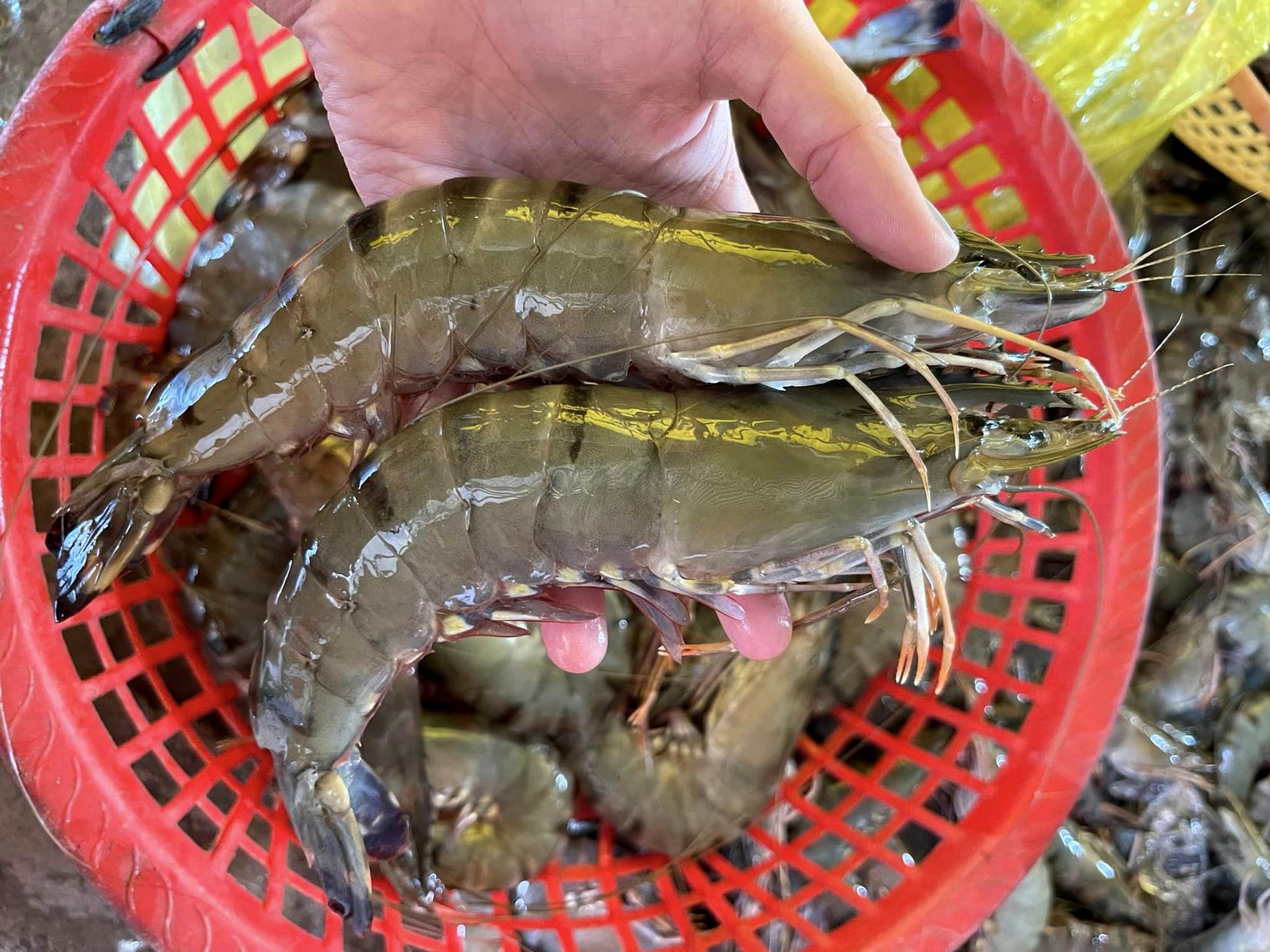November 27, 2025 | 21:48 GMT +7
November 27, 2025 | 21:48 GMT +7
Hotline: 0913.378.918
November 27, 2025 | 21:48 GMT +7
Hotline: 0913.378.918

Harvested black tiger shrimp in Ca Mau. Photo: Son Trang.
Prior to the year 2012, among the varieties of shrimp exported from Vietnam (including black tiger shrimp, whiteleg shrimp, lobster, and other shrimp species), black tiger shrimp consistently held the top position in terms of export value. However, with the robust development of whiteleg shrimp farming, from 2013 onwards, black tiger shrimp relinquished this position, descending to the second position in the overall export value of Vietnamese shrimp.
Despite no longer being the primary export product, black tiger shrimp continues to maintain a significant role within the Vietnamese shrimp industry. Firstly, it remains the largest cultivated shrimp variety. According to the Directorate of Fisheries (Ministry of Agriculture and Rural Development), in 2022, the total area of brackish water shrimp farming in the country reached 737 thousand hectares, of which black tiger shrimp accounted for 622 thousand hectares and whiteleg shrimp for 115 thousand hectares.
Having the largest area also means that a majority of shrimp farmers, especially those in the Mekong Delta region, rely on black tiger shrimp. These are small-scale farming households lacking the financial means and technical conditions to invest in constructing intensive whiteleg shrimp farming facilities. Consequently, they still utilize water surfaces for extensive or improved extensive black tiger shrimp farming, as well as employing integrated models such as shrimp-rice rotation and shrimp farming beneath saltwater mangroves.
On the other hand, Vietnam remains the world's largest producer of black tiger shrimp, followed by countries like Bangladesh, Indonesia, India, China, Philippines, Myanmar, and Madagascar.
Beyond its production advantage, Vietnamese black tiger shrimp also possesses another significant asset: a substantial number of sustainable certification suppliers. According to Mr. Tran Van Cong, Agricultural Counselor of Vietnam in Belgium and the EU, the primary suppliers of black tiger shrimp to Europe are Vietnam and Bangladesh. In this context, Vietnamese black tiger shrimp enters premium distribution systems due to its ASC certification. Conversely, Bangladesh's black tiger shrimp, lacking this certification, mainly enters low-tier distribution systems.
This year, amidst a global decline in shrimp exports due to high inflation and economic difficulties, black tiger shrimp exports have demonstrated positive growth in certain key markets.
According to the Vietnam Association of Seafood Exporters and Producers (VASEP), in the first six months of this year, Vietnam's shrimp exports to China and Hong Kong only reached 280 million USD, a 16% decrease compared to the same period.
However, while shrimp exports to China and Hong Kong declined, black tiger shrimp exports to these markets increased by 30%. In the composition of shrimp exports to China and Hong Kong during the first half of this year, black tiger shrimp ranked second after whiteleg shrimp, comprising a share of 25.3%.

Black tiger shrimp used to be the top-1 exporting shrimp of Vietnam. Photo: Son Trang.
The export prices of black tiger shrimp are also significantly higher compared to whiteleg shrimp. In the first half of 2023, the average export price of Vietnamese whiteleg shrimp to China ranged from 4.9 to 7.9 USD/kg, while the average export price of Vietnamese black tiger shrimp to this market ranged from 8.2 to 13.8 USD/kg.
Also according to VASEP, in the first half of 2023, while the export of whiteleg shrimp to South Korea decreased sharply by 30% compared to the same period, reaching only 140 million USD, the processed black tiger shrimp exports showed a slight increase of 2% in the first six months of this year.
The export prices of black tiger shrimp to South Korea are also notably higher than the prices of whiteleg shrimp. In the first six months of 2023, the average export price of frozen Vietnamese whiteleg shrimp to South Korea ranged from 7.7 to 8.2 USD/kg, whereas the average export price of black tiger shrimp ranged from 12.1 to 14.8 USD/kg.
In the context where Vietnamese whiteleg shrimp faces market competition disadvantages against similar products from India and Ecuador, Vietnam remains the world's top exporter of black tiger shrimp due to its largest production volume and superior quality. Therefore, Mr. Le Van Quang, Chairman of the Board of Directors of Minh Phu Group, believes that a balanced development strategy for black tiger shrimp is needed to enhance competitiveness for the Vietnamese shrimp industry.
Translated by Nguyen Hai Long

(VAN) According to Mr. Vo Minh Thanh, Director of the Tay Ninh Department of Agriculture and Environment, Resolution 57 has created a new development pathway for the locality, shifting from traditional toward modern agriculture.
/2025/11/26/4909-2-154329_878.jpg)
(VAN) Pearl grouper farming in HDPE cages not only delivers economic efficiency but also contributes to protecting the environment, creating jobs, and promoting marine-based experiential tourism.

(VAN) The model of making a living under the forest canopy through the agroforestry system in Van Son commune, Bac Ninh province, is expected to generate an annual income of approximately VND 30 million/ha.

(VAN) Many enterprises in Can Tho are harnessing natural energy and reducing greenhouse gas emissions in their production processes, thereby contributing to the promotion of a sustainable green transition.
/2025/11/24/3536-2-112800_176.jpg)
(VAN) Dong Nai now has tens of thousands of hectares of forests certified for sustainable management, and this area will continue to be expanded in the coming period.

(VAN) Vinh Ha hamlet (Dai Xuyen commune, Hanoi) is shifting away from small-scale farming as households adopt bioscurity into their breeder chicken models.

(VAN) Heavy rains make aquatic species more vulnerable to disease. Proactive water management and high-tech systems help farmers prevent outbreaks and protect yields.